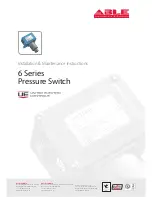
Gen VI Dimmer
User Manual
Page 42
10
PTFD Explained
10.1
Overview
PTFD
stands for “Pulse Transformer Fired Dimmer”. It is a tried and proven piece of dimmer
technology
that is used in top quality dimmers including LSC’s GEN·VI range. However, many
dimmer manufacturers now use low cost opto-isolator circuitry in their dimmers which can have
some short comings as described below.
10.2
What is PTFD?
PTDF
dimmers use a small “pulse transformer” to control their internal power control device,
usually a triac or an SCR. We will use
the Generic term “triac”. The triac is the part of the
dimmer that actually controls the voltage coming out of the dimmer to the load. A 12 channel
dimmer needed 12 transformers, one per channel. The transformer is used to provide isolation
between the high voltage (100-240v) mains output and the low voltage (~12v) of the dimmer
electronics. A pulsed signal is fed into the input of the transformer, and the output is connected
to the input of the triac. The result is a dimmer that can control virtually any type of connected
load. This includes inductive loads such as anything with a transformer in it. Examples are pin
spots, 12v EVL dichroic lamp systems, reactive loads, discharge lamps and fluorescent lamps.
In the 1980’s a new integrated circuit device became available known as an “opto-isolator” (also
known as an optocoupler or a MOC). This device uses a LED and a phototransistor to provide
the same level of high-low voltage isolation as a pulse transformer but at a far lower cost. Due
to the lower cost and the fact that an IC is easier to work with than a transformer in
manufacturing, the vast majority of dimmer manufacturers switched to this great new device.
10.3
Opto-isolated Problems
The opto-isolators used in low cost dimmers have one major disadvantage. They do not provide
the power to drive the triac! Instead, the dimmer circuitry relies on the connected load to power
the triac. Therefore, the opto-
isolated dimmer’s performance is dependent on the load
connected to it. In the case of a simple high power load such as a 1000 watt lamp this is not
usually a problem. The problems occur when you try to control any of the following loads:
•
Very low power circuits such as a 15w festoon lamp.
•
Inductive loads, such as Pin spots or ELV 12v dichroic lamp systems.
•
Transformers such as gobo rotator power supplies.
•
Motors, such as mirror ball rotators.
•
Motorised Disco Effects. These often contain a motor and a transformer.
•
Reactive loads such as Intelligent lights, Discharge lamps and Fluorescent lamps
If the load is very small there is just not enough power to fire the triac. The result is that most
opto-isolated dimmers require a minimum load of 100 watts in order to work. If the load is
inductive or reactive then there is a problem with the voltage and current getting out of phase
with each other which can cause a false trigger of the triac, which causes the lights to flicker or
flash. If the load is both of the above such as a small transformer driving a gobo rotator or a 35
watt dichroic lamp then some opto-isolated dimmers will turn on but never turn off, so your light
or gobo rotator keeps working at full power, even with the dimmer control at zero!
A PTFD dimmer rack does not have any of these problems. It simply dims the light as the
operation of the triac is completely independent of the load.
10.4
Hard Firing
Some manufacturers use opto-isolators
but employ a technique called “Hard Firing” to try and
overcome the problems listed above. Hard firing involves sending a string of small pulses to the
opto-
isolator (just like we do with our PTFD’s), so that if/when the triac misfires or turns off from
a lack of power, it will automatically re-trigger. Whilst this can help the situation the dimmer still
cannot control certain loads. Some sales jargon will try to convince you that Hard Firing solves
all the problems with opto-isolation. It does not!








































